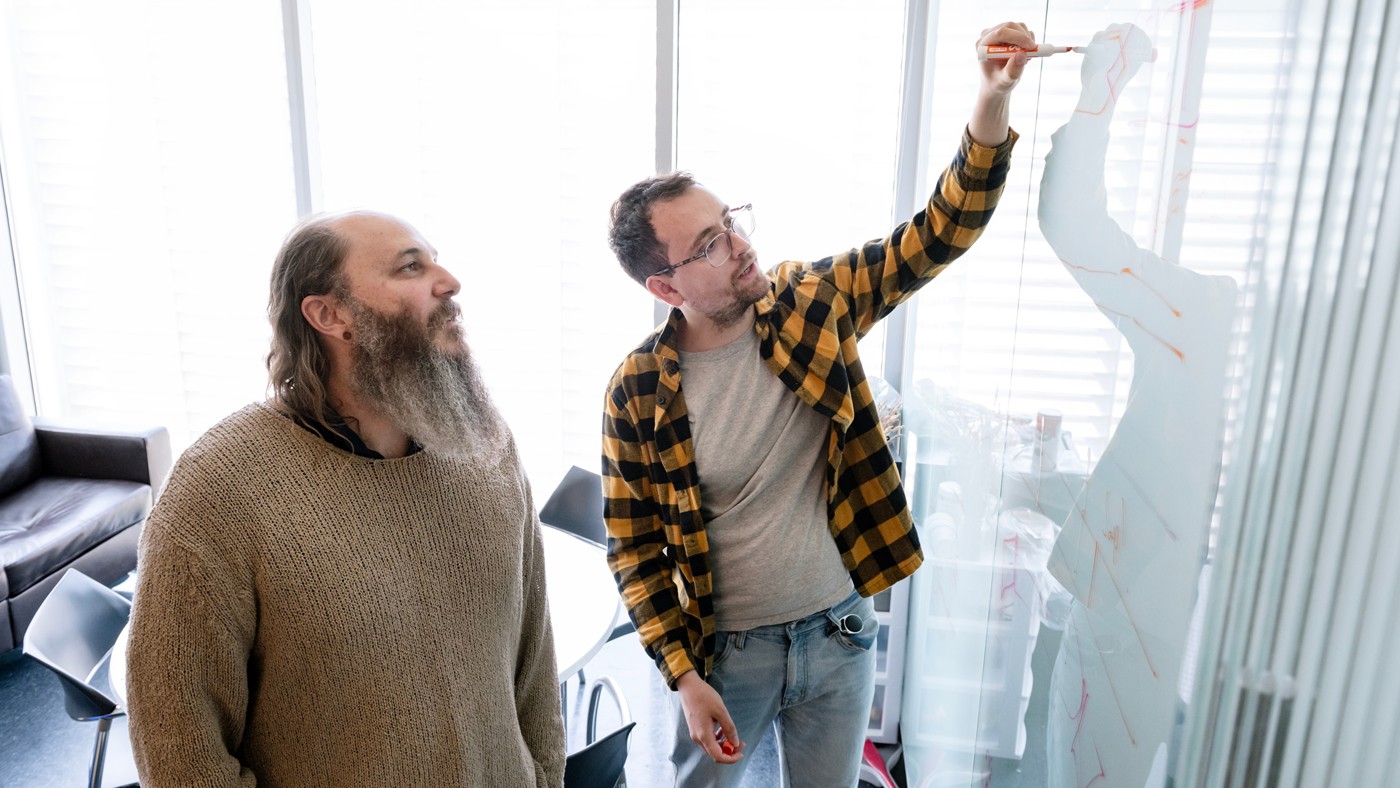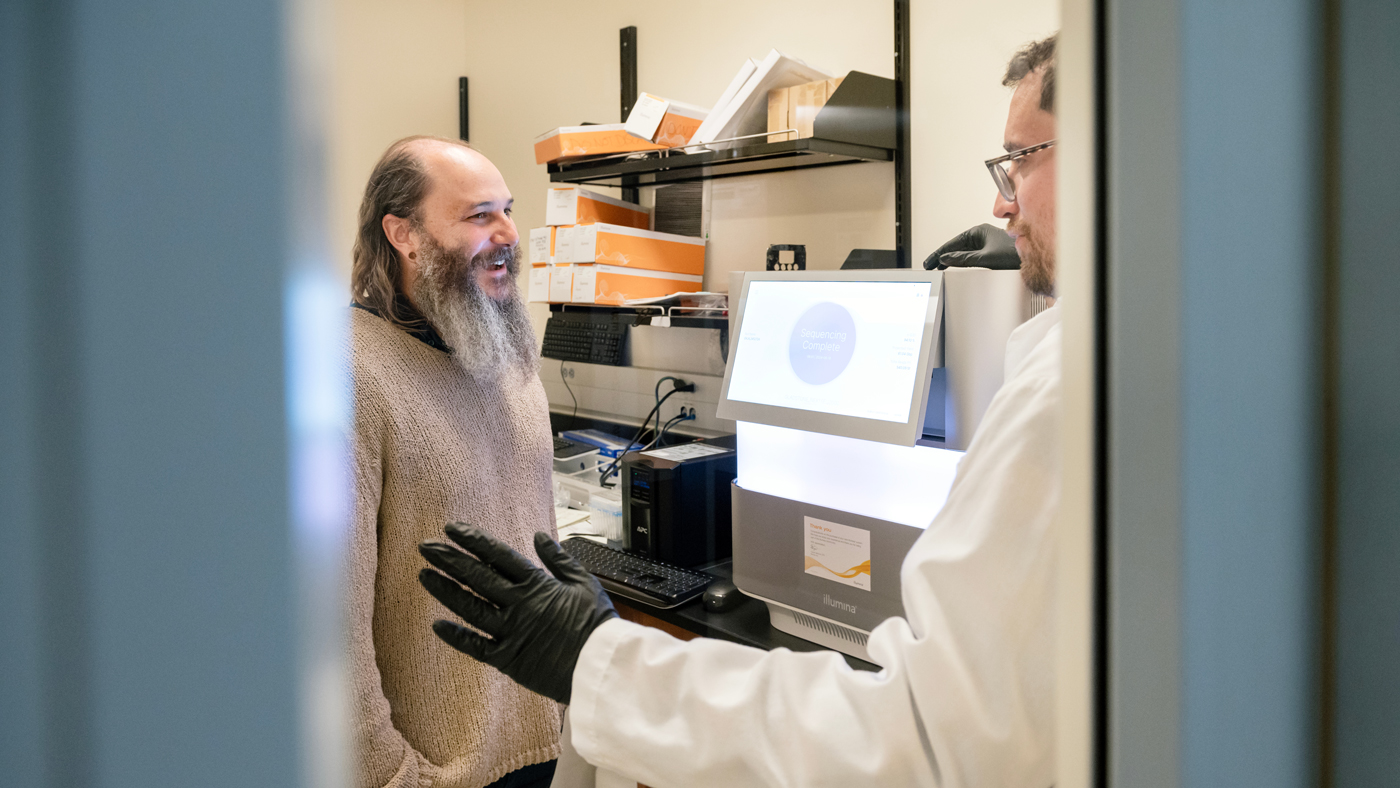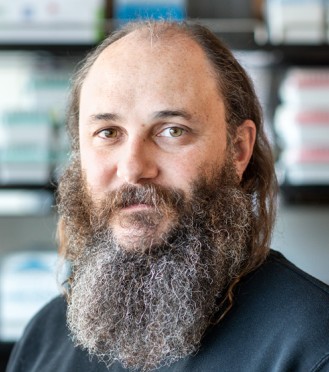Gladstone NOW: The Campaign Join Us on the Journey✕

Seth Shipman (left) and Alejandro González-Delgado (right) developed a more efficient way to make precise edits to human cells in multiple locations at once. Their study was published in the journal Nature Chemical Biology.
Genome editing has become a widely adopted technology to modify DNA in cells, allowing scientists to study diseases in the lab and develop therapies that repair disease-causing mutations. However, with current approaches, it’s only possible to edit cells in one location at a time.
Now, a team of scientists at Gladstone Institutes has developed a new method that enables them to make precise edits in multiple locations within a cell—all at once. Using molecules called retrons, they created a tool that can efficiently modify DNA in bacteria, yeast, and human cells.
“We wanted to push the boundaries of genomic technologies by engineering tools to help us study the true complexity of biology and disease,” says Associate Investigator Seth Shipman, PhD, senior author of a new study published in Nature Chemical Biology.
Conquering Limitations
Shipman is a leader in the nascent and fast-growing field of retrons, which are molecular components from a bacterial immune system that can produce large quantities of DNA. In 2022, by combining retrons with CRISPR-Cas9 genome editing, his lab pioneered a system to edit human cells quickly and efficiently.
With the new study, the researchers wanted to use their system to overcome a limitation of current genome editing methods.

González-Delgado helped engineer retrons so they can make multiple edits simultaneously to a cell’s genome.
“If you wanted to edit a cell in multiple locations of the genome that are not near each other, the standard approach before now was to make the modifications one after the other,” explains Alejandro González-Delgado, PhD, one of the first authors of the study and a postdoctoral scholar in Shipman’s lab. “It was a laborious cycle: you would first make an edit, then you would use the edited cells to introduce another edit, and so on.”
Instead, the team found a way to encode a retron so it can generate different portions of DNA. When delivered to a cell, these engineered retrons—called multitrons—can make multiple edits simultaneously.
Another benefit of multitrons is their ability to delete large sections of the genome.
“With multitrons, we can make sequential deletions to cut out and collapse middle portions of the genome region we’re targeting, bringing the far-apart ends closer together until the entire region is completely deleted,” says González-Delgado.
Many Potential Applications
As part of their study, Shipman and his team demonstrated immediate applications for their new method in molecular recording and metabolic engineering.

The new genome editing method developed by Shipman (left) and González-Delgado (right) will help researchers model complex genetic diseases in the lab.
Retrons, they have previously shown, can be used to record molecular events in a cell, providing a detailed log of the cell’s activity and changes to its environment. With multitrons, the researchers have expanded this approach and can now record with greater sensitivity.
“Multitrons allow us to record very weak and very strong signals at the same time, expanding the dynamic range of our recordings,” says González-Delgado. “Eventually, we could imagine implementing this type of tool in the gut microbiome to record a signal like inflammation.”
As for metabolic engineering, the scientists showed that multitrons can be used to simultaneously edit multiple genes in a metabolic pathway to rapidly increase the production of a targeted substance within a cell. They tested their approach on a powerful antioxidant called lycopene and successfully increased the production of this compound threefold.
“In order to start modeling complex genetic diseases and eventually find treatments or cures, we need to make many different mutations to cells at once,” says Shipman, who is also an associate professor in the Department of Bioengineering and Therapeutic Sciences at UC San Francisco, as well as a Chan Zuckerberg Biohub Investigator. “Our new approach is a step toward that.”
For Media
Kelly Quigley
Director, Science Communications and Media Relations
415.734.2690
Email
About the Study
The paper “Simultaneous multi-site editing of individual genomes using retron arrays” was published in the journal Nature Chemical Biology on July 9, 2024. The other authors are Santiago C. Lopez, Matías Rojas-Montero, and Chloe B. Fishman from Gladstone.
The research was supported by the National Science Foundation (MCB 2137692), the National Institute of Biomedical Imaging and Bioengineering (R21EB031393), the National Institute of General Medical Sciences (1DP2GM140917), the UCSF Program for Breakthrough Biomedical Research, Chan Zuckerberg Biohub San Francisco, the L.K. Whittier Foundation, the Pew Biomedical Scholars Program, the California Institute of Regenerative Medicine, and a Berkeley Fellowship for Graduate Study.
About Gladstone Institutes
Gladstone Institutes is an independent, nonprofit life science research organization that uses visionary science and technology to overcome disease. Established in 1979, it is located in the epicenter of biomedical and technological innovation, in the Mission Bay neighborhood of San Francisco. Gladstone has created a research model that disrupts how science is done, funds big ideas, and attracts the brightest minds.
Support Discovery Science
Your gift to Gladstone will allow our researchers to pursue high-quality science, focus on disease, and train the next generation of scientific thought leaders.
Zhaoqi Yan Named a 2025 Warren Alpert Distinguished Scholar
Zhaoqi Yan Named a 2025 Warren Alpert Distinguished Scholar
Gladstone researcher receives prize to study blood-brain barrier dysfunction and its impact on neurological disease.
Awards News Release Alzheimer’s Disease Neurological Disease Akassoglou LabKarin Pelka Wins Grant to Advance Immunotherapy for Colorectal Cancer
Karin Pelka Wins Grant to Advance Immunotherapy for Colorectal Cancer
The Colorectal Cancer Alliance has awarded Pelka a $500,000 grant to develop novel immunotherapies that overcome the most common form of colorectal cancer.
Grants News Release Cancer Pelka LabUltimate Self-Sacrifice: Bacteria Activate Unusual Defense to Evade Viral Attack
Ultimate Self-Sacrifice: Bacteria Activate Unusual Defense to Evade Viral Attack
Scientists discover that a well-known defense system in some bacteria can kill the cell as a last resort if viruses try to thwart it.
News Release Research (Publication) Virology




